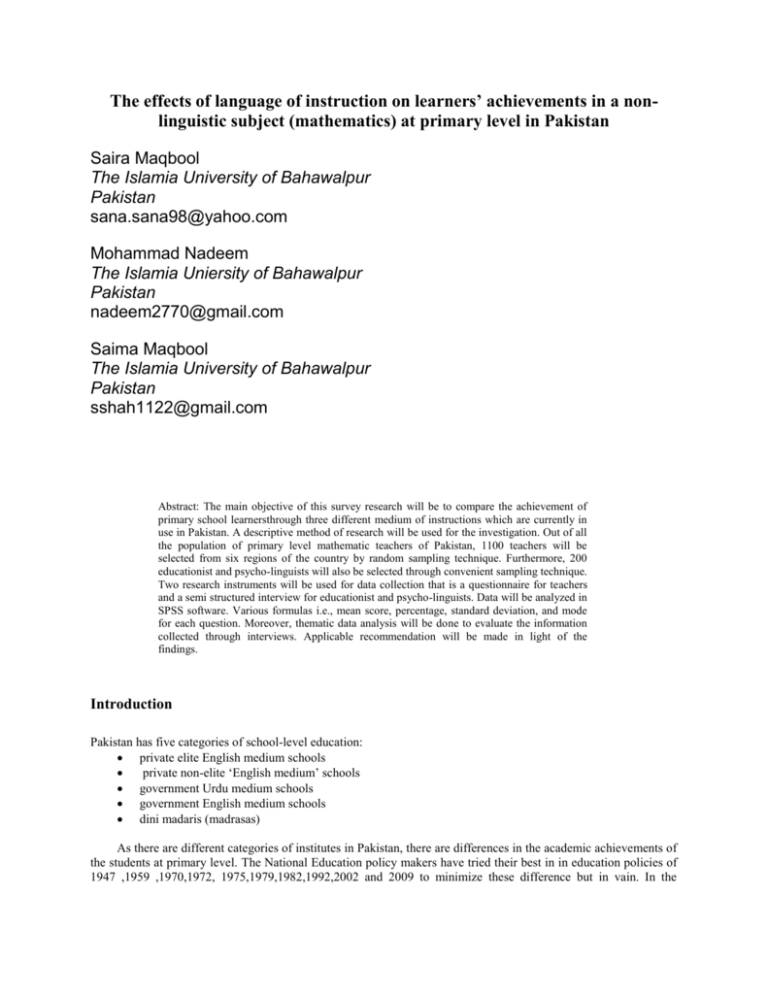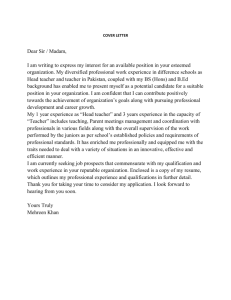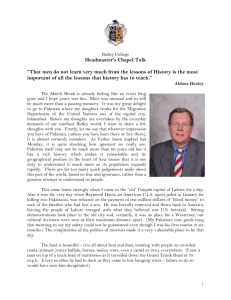The effects of language of instruction on learners` achievements in a
advertisement

The effects of language of instruction on learners’ achievements in a nonlinguistic subject (mathematics) at primary level in Pakistan Saira Maqbool The Islamia University of Bahawalpur Pakistan sana.sana98@yahoo.com Mohammad Nadeem The Islamia Uniersity of Bahawalpur Pakistan nadeem2770@gmail.com Saima Maqbool The Islamia University of Bahawalpur Pakistan sshah1122@gmail.com Abstract: The main objective of this survey research will be to compare the achievement of primary school learnersthrough three different medium of instructions which are currently in use in Pakistan. A descriptive method of research will be used for the investigation. Out of all the population of primary level mathematic teachers of Pakistan, 1100 teachers will be selected from six regions of the country by random sampling technique. Furthermore, 200 educationist and psycho-linguists will also be selected through convenient sampling technique. Two research instruments will be used for data collection that is a questionnaire for teachers and a semi structured interview for educationist and psycho-linguists. Data will be analyzed in SPSS software. Various formulas i.e., mean score, percentage, standard deviation, and mode for each question. Moreover, thematic data analysis will be done to evaluate the information collected through interviews. Applicable recommendation will be made in light of the findings. Introduction Pakistan has five categories of school-level education: private elite English medium schools private non-elite ‘English medium’ schools government Urdu medium schools government English medium schools dini madaris (madrasas) As there are different categories of institutes in Pakistan, there are differences in the academic achievements of the students at primary level. The National Education policy makers have tried their best in in education policies of 1947 ,1959 ,1970,1972, 1975,1979,1982,1992,2002 and 2009 to minimize these difference but in vain. In the educational policy 2009, language of instruction was the center of attention and it was declared that the achievement difference between the public and private schools is because private schools use English as medium of instruction. According to the British Council report (24th October 2010) on English language in Pakistan, a child in a government school will need a further 1.5 years to achieve what a child in Year 3 in a private non-elite school has achieved in mathematics in Urdu, whilst a government school pupil will need a further 2.5 years to achieve what a Year 3 pupil in a private non-elite school can do in English. Keeping in view this difference in achievement, the government has decided in the National Educational Policy 2009(NEP) to change the language of instruction in primary government schools from Urdu and regional languages to English language from the year 2004. The National Education Policy (NEP) 2009 is the latest in a series of education policies dating back to the very inception of the country in 1947. The question that is generally asked is that whether language of instruction is only responsible for the achievement gap between the performance of English medium and Urdu medium schools. Problem Formation The disparity between private English medium and government U rdu medium schools is more complex than merely ensuring a common medium of instruction. White Paper, the first public document of the education policy of 1998-2010, declares that since English is an economic necessity, it should be promoted as the national medium of instruction at primary level. The same document declares that since Urdu is our national language, it should not be ignored and should continue to be the language of instruction at primary level. Even still the same document argues that since in certain areas Urdu is perceived as an imperialist language, regional language should be the language of instruction at primary level. According to UNESCO (2006) there are 17,806,488 students enrolled in primary school, which makes 49.3% of the total students enrolled in Pakistan in 2006. We cannot simply ignore the major issue of language of instruction. A very through survey is needed to reach to the right conclusion or otherwise this issue will continue affecting the lives of millions of students in a negative way and our policy makers will still be confused in selecting English, Urdu and regional languages to be the medium of instruction at primary level. The present study would be undertaken to investigate the effects of language of instruction on leaners’ achievement in the subject of mathematics in class V Research Objectives Objectives of this research will be to: calculate the differences of achievement in the subject of mathematics the V grade learners through English as medium of instruction Urdu as medium of instruction Regional languages as medium of instruction investigate the problems faced by teachers while teaching mathematics using English/ Urdu/regional language as medium of instruction. provide logical and applicable recommendations for the policy makers to reach a definite answer about the selection of medium of instruction at primary level. Explore the psychological evidence behind the difference in achievement between students learning through different medium of instructions. Significance of the Research Education, curriculum and the medium of instruction have all been the subject of innumerable reports over the last fifty years. Language of instruction has been an issue of debate for educationist and policy makers since the 1st educational policy of Pakistan. This study will be of significant importance in deciding the fate of 1817580 primary school children (World Bank Report, 2010) since the policy of 2009 will be implemented in 2014 and will have its influence on these children if not properly amended. The study will be of great significance to policy makers and educationist as it will provide them with such insight that will help them in reaching a decision about language of instruction. Moreover it will also give such recommendation which will help them make a wise decision regarding instructional language at primary level in future. Literary Review Language is a symbol of identity, nationhood as well as power. That is why it has always been a difficult task for every government to make language planning. Through language planning a government can manipulate the linguistic situation in in a particular direction. Language used in academics is an important part of this planning. But if the government tries to impose a particular language by force, it may lead to failure. This is especially the case in a multilingual country like Pakistan. There are almost 72 different languages spoken in Pakistan. Major of these languages are Urdu, English, Pashto, Punjabi, Sindi, Balochi and saraiki. The following table shows how Pakistan’s language in education policy since independence. There has always been confusion among the use of English and Urdu and regional languages in academics, especially between Urdu and English language. It has been argued that this Urdu + English policy contributes to a sense of cultural anomie experienced by many people in contemporary Pakistan. Table 1: Medium of Instruction and Policies Implementations in Pakistan Year Pre1947 1947 Event Colonial rule 1959 Shareef Commission 1973 New Constitution 1977 Coup by Zia-ulHaq 1989 Benazir Bhutto elected New education policy Coup by Pervez Musharraf White Paper 1998 1999 2007 2009 Independence National Education Policy Policy Urdu medium for masses, English medium for elite Urdu declared to be national language Primary and secondary education in Urdu, higher education in English English to be replaced by Urdu within 15 years; provinces free to develop their own language policies Islamisation and Urduisation English to be taught from Year 1 No statement regarding language policy English to be taught from Year 1 ‘where teachers are available’ English to be taught from Year 1; mathematics and science to be taught through English from Year 6 Science and mathematics to be taught through English in Years 4 and 5; all science and mathematics to be taught through English from 2014 Implementation As Policy Urdu medium English medium for elite No change for masses, No change English taught from Year 4; schools begin to prepare for Complete Urduisation of exams by 1989; private English medium schools begin to grow Little effective change Private English medium schools flourish Little effective change Little effective change; in Punjab science taught through English from Year 10. Punjab declares science to be taught through English starting in Year 4 from April 2009 The current National Education Policy 2009 discusses medium of instruction in primary schools as a main issue under the following categories. English as medium of instruction Urdu as medium of instruction Regional languages as medium of instruction English as medium of instruction According to the British Council Annual Report (2010) on English language in Pakistan, a child in a government Urdu medium school will need a further 1.5 years to achieve what a child in Year 3 in a private nonelite English medium school has achieved in mathematics, whilst the government school pupil needs a further 2.5 years to achieve what a Year 3 pupil in a private non-elite school can do in English. Currently, the government appears committed to moving towards all education being in English, a move that is unlikely to be possible given the parlous state of our teacher cohort. Urdu as medium of instruction Since Urdu is the national language of Pakistan, its importance cannot be ignored in academics. The education policy 2009 gives the status of language of instruction to Urdu language at primary level. Regional languages as medium of instruction It’s a child’s right to have initial level education in his mother tongue. Research has proved that a child learns more easily in his mother tongue rather than a foreign language. It is considered to be an important component of quality education, particularly in the early years. Keeping this view in mind the education policy 2009 also adds that the provinces will be allowed to use mother tongue as language of instruction at primary level. Table 2: Pakistan’s Linguistic Picture Languages Urdu(official language) Punjabi Sindhi Others(Pushto,Saraiki,Balochi and Brauhi) % of the population 9%(speaks as first language) 65% 11% 24% Table 3: Educational Institutions by Medium of Instruction in Pakistan TYPE Public Private Total Boys Girls Mixed Total Boys Girls Mixed Total Boys Girls Mixed Total # of Institutions 50265 41878 59601 151744 6597 7602 61847 76047 57868 48475 121448 227791 Medium of Instruction % Urdu English 32.2 1.2 30.6 1.4 48 1.6 68.3 1.4 63.7 10.7 44.4 1.4 58 32.1 57..2 28.4 77.3 2.9 78.3 2.6 53.1 17.1 64.6 10.4 Sindhi 7.5 6.7 43.4 22.4 2.6 1.3 1.7 1.8 6.7 9.3 22.2 15.5 Others 9.1 11.3 7 7.9 23 52 7.7 12.7 13.2 9.8 7.6 9.5 Medium of Instruction at Primary Level There exist many arguments in favour of mother tongue as medium of instruction. Teaching a child in the language it speaks at home brings parents closer to the education process and allows them a participation in their child's education that is impossible if the language the child is taught in is 'foreign' – be it English, Urdu or any other. Children learn more quickly and easily in their mother-tongue because there are no barriers to comprehension, and in our deeply schismatic society all communities can feel equally respected if their children are educated in their native language. On the other hand there are many arguments in favour of making English language as medium of instruction at primary level. English is a lingua franca and the only way to get a white colour job. Moreover it has been linguistically proved that languages are learnt more easily at an earlier stage than at a later stage. The following three policy statements taken together raise a number of questions in Pakistan: Despite the statement that any language can be used in Classes I to V it is also stated that English must be used for teaching science and mathematics in Classes IV and V. Urdu and regional languages can be used for teaching science and mathematics between 2009 and 2014. From 2014 English must be used for teaching science and mathematics. So what should be the language or languages of instruction. Urdu, the national language and the urban second language or Punjabi, the language of 44.15 % Pakistanis Or Sindhi, the language of 14.10 % people and a language used in the education system, media, administration and judiciary in Sindh or Pashto, a very important language spoken by 15.42 % people and also used in Afghanistan. These are important questions which can only be answered in the light of our values. That is why those with different values will have different answers. The government is trying to bridge the gap between the performance of English medium and Urdu medium schools by introducing English as medium of instruction but we ignore the facts that over 50 percent of Pakistani youth do not complete the first eight years of basic education: many drop out due to a combination of the factors below; * Many schools are without proper — even any — infrastructure; * Children do better at school when they come to school with a full tummy; * Class sizes are often far too large with multiple grades in one class; So the disparity between private and government schools is much more complex than merely ensuring a common curriculum and medium of instruction. Should a decision about language policy be made without first understanding the road to effective literacy and what makes children succeed or fail in school? Research Methodology The current study essentially will be descriptive in nature. The strength of population and need to generalize the research findings support survey method. Data will be collected keeping in view various points regarding medium of instruction in the national education policy 2009. The other factors of research methodology will be as under. Population As the focus of the investigation will be the achievements of primary school students in mathematics through English, Urdu and regional languages, the population will contain all the teachers male/female who are teaching mathematics (of both private and public sector schools) to grade V students in Pakistan. The population will include seasoned psycho-linguists both indigenous and foreign. Sample The study will seek to select such accessible sample that will be the representative of all the population. Convenient sampling technique will be used to select the sample from various districts of all the provinces. In order to get true representative sample two districts from each province and one district from each region will be selected. 11 districts from all over the country will be selected as sample for data collection. District-wise stratified random sampling technique will be made of schools within each area (one mathematics teacher from each school) in order to reach the number of study sample for each district which are given in the following tables. Table 4: Sample of the study S. # Province/regions Districts No.of Schools 1 Punjab 120 2 3 Sindh KPK 80 80 180 180 4 5 Baluchistan FANA Lahore, Shaikhupura, Multan Karachi, Sukhar Peshawar, Abbotabad Quetta, Sibi Gilgit Baltistan No.of mathematic teachers 420 40 30 140 130 6 AJK Muzaffarbad 10 10 7 Total ICT Islamabad 40 1100 40 1100 200 learned educational authorities and psycholinguists will be selected as per convenient sampling from different parts of Pakistan as well as from abroad. Table 5: Total numbers of Educationists and Psycho-lingusitcs S. # From Pakistan Foreign Total Educationists 90 10 100 Psycho-linguistics 90 10 200 Research Tool Following two types of research tools will be used to collect the data. Questionnaire Interview The main research instrument for the study will be a questionnaire for teachers which will be designed for data collection. It will be developed by the researcher after a profound review of related literature. It will be prepared on five-point Likert scale. The items of questionnaire will be based upon important aspects of teaching/learning challenges faced by the teachers in primary schools of the country. Two hundred follow up interviews will be conducted from the respondents i.e. educationists and psycholinguists, who will show their willingness for interview. Focus of the interviews will be to explore the effects of different languages as medium of instructions on the learners’ achievements at primary level. Validity & Reliability The modern concept of validity goes beyond the traditional definition of the validity. According to Fraenkel & Wallen (2007) validity refers to the appropriateness, correctness, meaningfulness, and usefulness of the specific inferences which the researcher(s) made on the bases of collected data. Content–related evidence of validity i.e. content, format, appropriateness and comprehensiveness of the instrument as well as construct-related evidence of the instrument validity i.e. clarity of research objectives and clear description of research questions will be ensured with consulting five senior educationists and researchers separately. Instruments of the study will be tested and finalized in the light of the feedback received as a result of pilot testing. Pilot testing will be conducted in district Rawalpindi. Necessary changes will be incorporated in the research instruments. To ensure the validity and reliability of the instruments, the questionnaires will be administered to one hundred teachers of primary level and spilt-half procedure will be used to calculate reliability of the instrument. It will also be found out by using SPSS software. Data Collection The researcher will personally visit the sample institutions and get the questionnaires filled from the target sample. It will be tried that maximum numbers of respondents would provide responses. Interviews will be conducted (face to face or through video conference calls whichever will be feasible) from those educationists and as well as from psycho-linguists who will show their willingness for interviews. Data Analysis Data gathered through research instruments will be recorded in two SPSS files. In first phase of the data analysis, reliability of the data will be manipulated. Reliability of the tool is defined with the stability, consistency and accuracy of the acquired results. Co-efficient of equivalence and co-efficient of internal consistency will be calculated using SPSS software. In the study, one way ANOVA will be used to estimate the variance among the students’ achievements. Percentages and mean scores of the scales, its subsections and other items of questionnaires will lead to draw the research findings. Qualitative data collected through interviews will be analyzed using content analysis approach. Profound study of the interview manuscripts will lead to find out emerging themes in the data. The themes will be categorized in next step of the content analysis and, finally, the comprehension of the professional challenges of teacher education graduates will be sought. Research Contribution The foreseeable contributions of this research are: Academic It is clear that there is a contribution to be made when researching the effects of different languages used as medium of instruction that is Urdu (national language), English (international language) and regional languages . Since 1953, UNESCO has supported children’s right to learn through mother tongue, and advocated maintenance of linguistic and cultural diversity through language-in-education policies (UNESCO, 1953: 2003). For a non-linguistic subject such as mathematics at primary level decision regarding selection of a medium of instruction is to be made after carful considerations. While intention is good for use of English as medium of instruction, its impact may be negative. According to Rehman (2009) education is to impart knowledge and information that encourages critical thinking. If it is so then the why should we impose a foreign language upon young learners. This research will help policy makers reach a conclusion regarding the selection of medium of instruction for non-linguistic subjects at primary level . Practical Contributions of Research The practical contributions will include: • Providing a framework for language of instruction to be used. • Further research into the area of language of instruction in different languages that is Urdu, English and regional languages. • Recommendations into language and educational planning at primary level. • Understanding the dynamics of mother tongue as medium of instruction. References Ahmad M. (n.d) Extroversion and Introversion: The Study Revealing Their Impact On L2/Efl Proficiency. A Chronological Review of Education and Language Policies in Pakistan. Unpublished Doctoral Dissertation at The Islamia Universiy of Bahawalpur, Pakistan Cleeg, J .Afitska O. (2010) Ed Qual policy Brief No.2. Language of Instruction and Quality of Learning in Tanzania and Ghana. Retrieved data on 23-08-2012 from http:// www.edqual.org/publications/policybriefs/pb2.pdf Clegg , J. (2010). Joint RPC Conference. Education Access Quality and Outcomes in Low and Middle Income Countries. Retrieved data on 11-09-2012 from http://www.edqual.org/publications/presentations/Langofinstruction.pdf Lynd, D. (2007). The Education System in Pakistan. Assessment of National Education Census. UNESCO. Published by UNESCO ISBN 978 969 8035 06 8.Islamabad, Pakistan Government of Pakistan (2008).Education for All, Ministry of Education, Government of Pakistan, Islamabad. Government of Pakistan (2009). National Education Policy, Ministry of Education, Islamabad. Government of Pakistan (2010). Pakistan Education Sector Reforms Efforts for health and addiction. Retrieved from http://www.moh.govt.nz/moh.nsf/pagesmh/ information habits of college students [White paper]. Retrieved data on 15-09-2012 from http://www5.oclc.org/downloads/community/informationhabits.pdf Ministry of Education (2010) Problems in the Implementation of National Education Policies (NEPs) at Elementary level Academy of Educational Planning and Management. Government of Pakistan, Islamabad. Retrieved data on 13-09-2012 from http:// www.aepam.edu.pk/Files/Publications/NEP.pdf Ministry of Education (2003) National plan of action on Education for all. 2001-2015 Pakistan. Retrieved on 1009-2012 from http://planipolis.iiep.unesco.org/upload/Pakistan/Pakistan%20EFA%20NPA%202003.pdf Ministry of Education. ( 2009). National Education Policy. Government of Pakistan, Islamabad. Ministry of Education. (1998) National Education Policy, Government of Pakistan. Islamabad. Ministry of Education. (2001) Education Sector Reforms: Strategic Plan 2002-2003. Islamabad . Ministry of Health. (2008). Let's get real: Real skills for people working in mental OCLC Online Computer Library Center. (2002). Rahman.T.(year).Language Policy and Localization in Pakistan: Proposal for a Paradigmatic Shift.1-2.Retrieved on 12-09-2012 from http://www.apnaorg.com/research-papers-pdf/rahman-1.pdf Saleem Mansur (n.d) The New Blueprint for Pakistan's Education Policy: An Analytical Review. Policy Perspectives, Volume 4, No.2.Institute of policy studies ,Islamabad Retrieved data on 12-09-2012 from http://www.ips.org.pk/the-muslim-world/1009-the-new-blueprint-for-pakistans-education-policyananalytical-review.html Shamim, F. (n.d).English as the language for development in Pakistan: Issues, challenges and possible solutions Dreams and Realities: Developing Countries and the English Language .British Council. Retrieved From http://www.teachingenglish.org.uk/sites/teacheng/files/Z413%20EDB%20Section14.pdf UNESCO. (2003). Education in a Multilingual World Paris: UNESCO. Why Gender Equality in basic Education in Pakistan. Published by UNESCO Islamabad, Pakistan. UNESCO. ISBN 978-969-8035-09-9 (Electronic version) World Bank Indicators-Pakistan-Participation (n.d) Primary Education Enrollment of Pakistan. retrived data on 12-09-2012 FROM http://www.tradingeconomics.com/pakistan/school-enrollment-primarypercent-gross-wb-data.html








